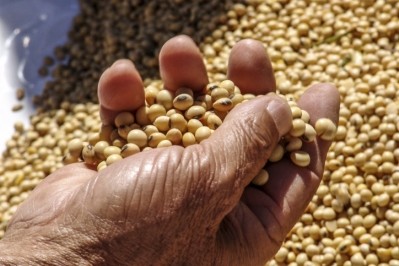Feed Protein Innovation
Danish study finds little resistance to the use of slaughterhouse waste in fish feed

The authors, writing in Aquaculture, found fish feed producers they had surveyed were willing to use protein derived from pig bristles and hooves as raw material if the quality and price requirements are met. They said fish farmers showed a general acceptance for feed produced from such protein sources if the price was competitive with that of fishmeal.
Given the growing demand for fishmeal and fisheries products by the global feed and food sectors, the researchers, based at the University of Copenhagen, BioMar and Danish Crown, said it is critical that alternative sources of feed protein raw materials are explored.
Their study was undertaken as part of Denmark’s Keratin2protein project, an initiative involving academic and research institutions, along with industrial players in the feed production sector that is aiming to apply microbial technologies to the conversion of such slaughterhouse waste so as to turn it into high value protein raw material for fish feed.
Large volumes of slaughterhouse waste are produced annually and there is a high cost attached to disposing these wastes, said the authors. “In 2013, around 222,000 tons of wet pig bristles and hooves were produced in the EU (EUROSTAT, 2015). The cost of disposing of that waste was estimated to be slightly over €4m.”
Pig hooves and bristles do not possess the exact same nutritional value as fishmeal. However, they noted the keratin2protein project partners are exploring a gentle method of processing to ensure increased concentrations of intact amino acids, digestibility and nutritional value of the final product (Espersen et al., 2015), said the researchers.
While the development and testing phase of that Danish project is only at the initial stages, those involved want to determine the possibilities for use of the proposed pig based raw material in the fish feed value chain. They want to see that farmers are willing to use feed produced from this raw material and to know the extent to which they are willing to pay for this type of feed.
“Although social acceptability of alternative fish feed resources has been addressed in some studies (Cox et al., 2008), to the best of our knowledge no specific focus has been given to the use of pig bristle and hooves resource, a gap the current study seeks to address.”
Method
The authors said they used a contingent valuation (CV) method - a survey based economic valuation technique that measures individual's willingness to pay (WTP) for a good or service in a hypothetical market (Bateman et al., 2002).
The team sent out two separate questionnaires for fish feed producers and fish farmers respectively comprising sections on respondents' preference and willingness to pay for respective products produced from pig bristles, their knowledge and attitude towards feed raw materials and feed respectively, and their demographic and production characteristics.
In total, 339 questionnaires were distributed to farmers in Denmark, Germany, Austria, Norway, UK, Poland, Spain and Australia. The researchers said they received 72 answers, which represented a 21% response rate.
The fish feed producers sample size comprised eight major companies including Tongwei, Biomar group, Aller Aqua, Nireus, Perseus group, Havsbrun, Skretting, and Ewos.
“An online questionnaire was sent to the companies' email addresses with an attention line, ‘production manager’. Direct contact emails were used for companies that provided this information on their websites. E-mails were only sent to the companies' head offices. Responses were received from half of the sample.”
FeedNavigator is hosting a free to access webinar on December 6. Join us as we talk to André Dumas, director of fish nutrition, the Center for Aquaculture Technologies in Canada, Dr Rune Waagbø, research director, NIFES, Philip Lyons, research scientist, Coppens International and John Sweetman, Alltech’s European technical manager for aquaculture about novel proteins, gut health, and the general formulation challenges the fish feed industry faces today.
Results
The results, wrote the authors, show that some level of willingness to use the raw materials from pig hooves and bristles exists today. “The price of this raw material however, needs to be relatively low to warrant uptake and utilization by the feed producers.”
Protein digestibility emerged as the most important factor that fish feed producers consider in a raw material, noted the researchers.
Other factors considered as having a higher importance include price, material safety data sheet requirement, legislative approval, amino acid profile and digestibility, and that the raw material is from marine protein source.
The findings underline that novel raw materials for fish feed need to meet the following quality requirements:
• Minimum crude protein content of 70%,
• Sum of amino acids of at least 88% of the crude protein
• Minimum protein digestibility of 85%
• Minimum amino acid digestibility of 88%
• Approval for use in the EU.
“These are the minimum nutritional requirements preferred by most feed producers, and [ones that] the novel technology being developed by the [Keratin2protein] project aims to achieve.”
The aquaculture industry is projected to grow at a rate of 4.14% per year through 2022, with the bulk of the production continuing in the Asian countries. This growth will likely be supported by increased investment in the sector, especially in areas of water use, breeding, hatchery practices, and feedstuff innovation (OECD/FAO, 2014).
Consumer concerns
All the respondent companies affirm that existing legislations allow them to use animal by-products as raw materials in fish feed. However, one company said it does not employ such feed components citing consumer resistance to the use of such products.
“Based on these concerns, the company expressed unwillingness to use the pig bristles raw material.”
The authors acknowledge that to validate such concerns, the Danish project team would need to investigate consumers' perceptions about protein from slaughterhouse waste.
They said the feed producer in question specialized in salmon grower feed:
“This outcome could be an indication that salmon feed producers could be more careful in their choice of feed ingredients.
“A study by Burr et al. (2012) shows that replacement of fishmeal with alternative protein blends impacts negatively on growth of juvenile Atlantic salmon. Such findings could be the contributing factor to the reservations by the salmon feed producer in accepting the proposed raw material.”
The main protein raw materials being used by the surveyed feed producers include fishmeal, soymeal, wheat, sunflower, wheat gluten, and vegetable concentrate. Some the respondents said they also used corn gluten, and land animal products.
Source: Aquaculture
Published online ahead of print: https://doi.org/10.1016/j.aquaculture.2017.04.029
Title: Use of pig by-products (bristles and hooves) as alternative protein raw material in fish feed: A feasibility study
Authors: FG Gachango, KS Ekmann, J Frørup, SM Pedersen









